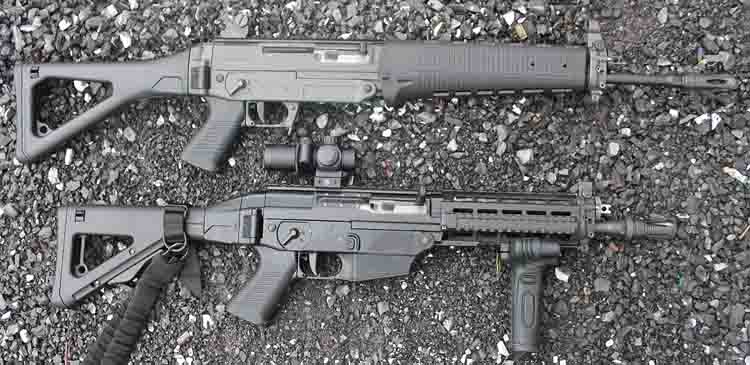By Todd Burgreen
Certain weapons have morphed into legendary status in the minds of the American gun community. This is often spawned by restricted supply of the weapon, which only serves to exacerbate the desire to possess. This can be caused by limited production or more likely onerous import restrictions that have been imposed on the market. The CZ 75 handgun comes immediately to mind as one example of this. Another weapon in this class is the SIG 550/551 series of rifles. A quick search of forums, books, anecdotal reports, and articles see the SIG 550/551 often labeled as the “World’s Best Assault Rifle” only heightens individual’s desires to possess such a widely acclaimed weapon. To say that very few semiautomatic SIG 551s made it into the U.S. before the Clinton Assault Rifle ban is an understatement; while exact figures are spotty it would seems only a few hundred SIG 551’s made it to the U.S. before the ban took effect.
SIG Sauer, Inc. is an American based company that was often looked to as the most logical source of releasing the pent up expectations related to the demand for SIG 550/551 rifles. The logical solution of importing “true” SIG 550/551 rifles from SIG Sauer’s sister companies located in Europe is ruled out due to parts compliant import regulations. While making no sense it is pointless to beat our heads against this wall as it is the law. Working to comply with import regulations and satisfy perceived market demands, SIG’s initial response to tapping the 550/551 market was by producing the SIG 556 model here in the U.S.
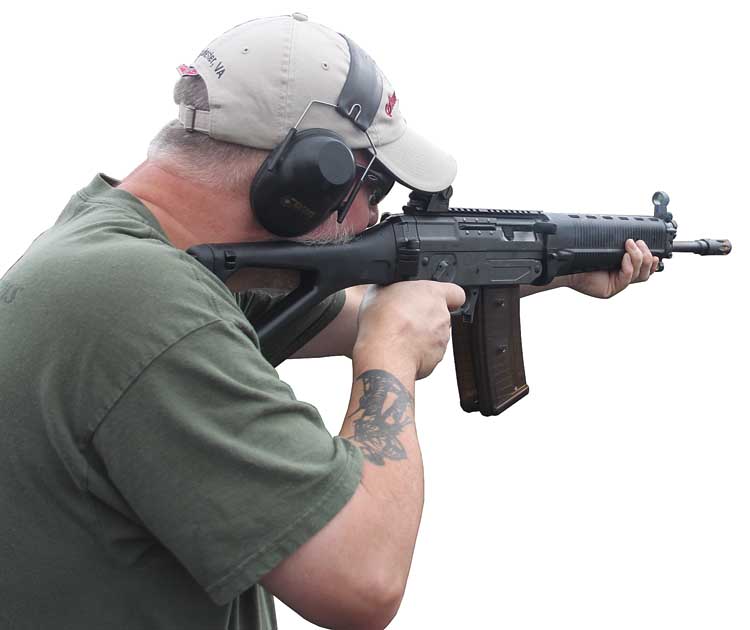
The SIG 556 immediately struck many as a valid option to the AR-15/M16 platform with its introduction in the U.S. While the SIG 556 product line accepts AR-15/M16 magazines (a major plus for many), its root design is based on the Swiss SG 550/551 and thus resembles the Kalashnikov in actual operating method. It utilizes an adjustable gas-piston operating rod system with a rotating bolt and carrier very similar to the AK’s in configuration. The SIG operating rod system is often referred to as the Porsche of AK designs due to the tighter tolerances and better workmanship found in SIG weapons compared to other manufacturers using the AK as a basis of design combined with tweaks that SIG made to the design. The gas-piston operating system keeps the action cleaner, cooler, and overall more reliable.
Some in the U.S. market who waited on SIG’s entry into the “black” rifle market were disappointed by the SIG 556. To be clear, this was not due to performance, but based on not receiving an exact copy of the legendary Swiss Army SIG 550/551 series of rifles. Collectors are a hard crowd to please. In a nutshell, SIG 556s created a lower that would accept AR-15 magazines. While allowing for AR magazines use in the SIG 556 made sense to many as evident by its sales performance and popularity, the people looking for a “cloned” 550/551 were left feeling flat even though the proven two-position gas adjustable gas-piston operating rod system found at the heart of 550 series was maintained in the 556’s design as well as many other part interchangeability.
Certain specific market segments were not looking for magazine convenience based on the plethora of AR magazines in the U.S.; they wanted what had eluded them for decades in a true to form SIG 550/551. SIG has recently responded with the SIG 551-A1. The SIG 551-A1 is produced in SIG’s Exeter, NH manufacturing center. The advent of modern CNC machines affords SIG the ability to produce a 551-style lower receiver that accepts the 550/551 style molded magazines and features a paddle style a la AK47 magazine release as found on the original Swiss offering. Along these lines, SIG chose to use aircraft grade aluminum alloy forgings that allow for CNC manufacturing techniques compared to the 550-series stamped receiver. This saves a pound of weight in the 556-series and now the 551-A1 compared to the 550-series. There are other differences in the 551-A1 compared to the original Swiss manufactured 551 that will be highlighted as the article progresses, but first, a little history on the original Swiss SG 550/551.
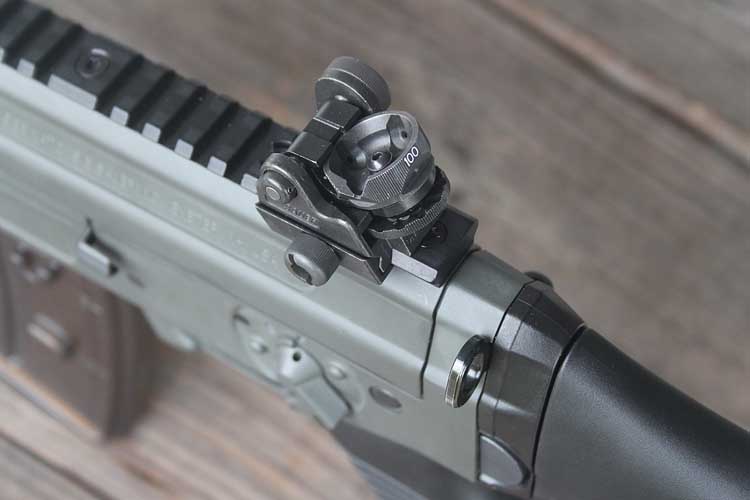
The SIG SG 550/551 design dates back to the late 1970s as the Swiss sought to replace their Stgw 57 battle rifle. From the beginning, specifications highlighted the desire for a modular design with various model variants expected such as compact and marksman type weapons. The SIG SG 550 (20.8 inch barrel) and the SG 551 (14.3 inch) carbine version were adopted in 1983, put into production in 1986 with final widespread introduction into the Swiss service in 1990. The SG 550 series was chambered in the Swiss equivalent of the 5.56mm in lieu of the earlier 7.5mm round and experimented with 6.45×48. The SG 550/551 functions with a piston-driven long-stroke action operating a rotating bolt. The whole system bears resemblance to the AK action with Swiss refinement and tweaks. For example, the SG 550 barrel is screwed into the receiver compared to the AK’s barrel being “pressed” into a front trunnion. Furthermore, the action recoil spring is located in front of the SG 550 action versus AK’s spring in the rear. A gas cylinder with a gas channel directs gasses tapped from firing a cartridge to a piston head that pushes the piston and bolt carrier rearward working the action. The piston moving backward removes its alignment with the gas channel cutting off the supply of gas acting on the piston. Surplus gases are directed out of an exhaust port. This system eliminates the “over” gassed characteristic inherent in the AK making the 550/551 run smoother and thus more accurate and less prone to wear over its service life.
Accuracy requirements were stringent with the SG 550/551 reflective of the Swiss emphasis on marksmanship in its citizen soldiers. Literature discovered during research of the article indicates that random SG 550 rifles tested before leaving the factory had to deliver no greater dispersion than 4.3 inch windage and 2.8 inch elevation groups at 300 meters from the bench using Swiss GP 90 service ammunition. The SG 550/551 gas system is adjustable via a two-position valve. One setting is for normal operation and the second is for more adverse conditions stemming from fouling or weather conditions. Another important nuance offered in the SG 550 series over the base AK is the adoption of a hinged lower/upper receiver style. This allows for permanently attached diopter drum rear sight via soldering at the rear of the receiver compared to the AK’s sight location in front of the action due to the removable dust cover. A longer sight radius translates into more accurate fire placement. The sight radius on the SG 550 is 21.3 inches. Another benefit that may not have been fully appreciated in the 1980s is the easy mounting of optics via Picatinny rail incorporated into the upper receiver. Hardly a battle rifle in use today does not sport a red dot or low powered optic of some type. Lastly, the folding stock on the SG 550 provided proper cheek alignment no matter if a soldier was prone, kneeling, or standing: this is not an easy accomplishment and a credit to the designers. In quick summary, the Swiss got the SG 550/551 design right as is evident by the acclaim and positive reports it has received over decades of use by various units and armed services. This all leads back to the opening paragraph referencing the near-fanatical following in the U.S. raising vociferous cries for a U.S.-legal 551 variant. SIG Sauer is attempting to satisfy this with the SIG 551-A1.
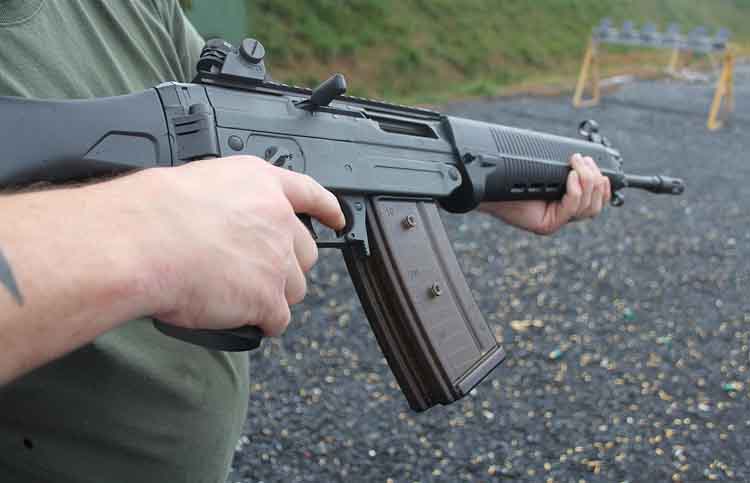
The SIG 551-A1 features a flat-top upper receiver with a Picatinny rail for mounting optics or other aiming devices. One unique feature of the SIG 551-A1 is the detachable Rotary Diopter Sight System (RDSS) that comes standard with rifle. The SIG RDSS with a rotary drum rear sight and front post is more substantial than most iron sight configurations. A shooter is well served by the RDSS if an optic device is not utilized or goes down. The RDSS stems from the SG 550 heritage and is befitting a service rifle that relies solely on its open sights to engage targets. However, recent trends in fighting rifles would indicate the design intent for the SIG 551-A1 is to mount some sort of low powered magnified optic or red dot as the primary sighting tool. Thus the RDSS mounts on the Picatinny rail and is removed in lieu of the permanent nature of the SG 550/551 diopter sight.
The SIG 551-A1 model is chambered in 5.56 NATO, weighs 7 pounds, measures 36.1 inches with folding rear stock deployed and 26 inches folded. As stated earlier, SIG’s decision to use a forged aluminum lower with the 551-A1 instead of 550/551 stamped saves about a pound in weight. The folding stock positively latches when closed and unfolds securely for steady shouldering. The 551-A1 flash suppressor uses a .5×28 thread pattern for attachment and is slightly longer than a typical AR-style birdcage flashhider and is different than the SG 550/551 pattern flash hider. The SIG 551-A1 features an ambidextrous safety selector and two-stage trigger similar to the SG 550/551 design. The 551-A1 has a 16 inch military grade cold hammer forged barrel with 1:7 twist. The original SG 550/551 barrels featured a 1:10 twist due to the Swiss GP 90 ammunition having a lighter bullet than the standard NATO SS109 cartridge. The barrel profile is different with the 551-A1 than the SG 550/551 as well.
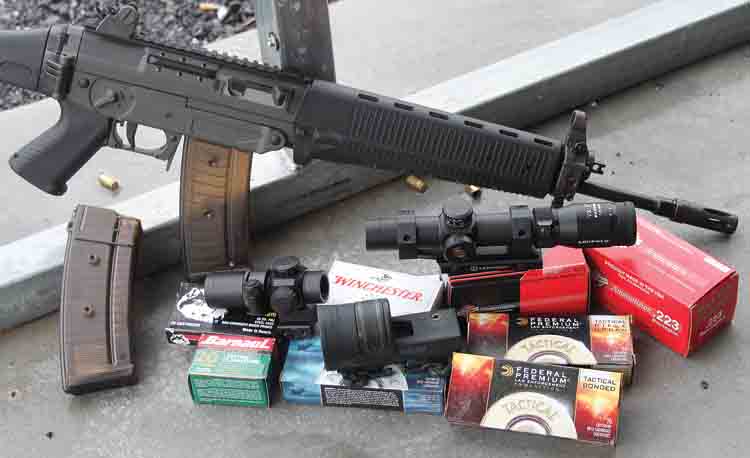
The 551-A1 utilizes Swiss 550-type transparent polymer magazines that can be coupled together ad infinitum with two being the norm and no more than three practical. A paddle style magazine release rests behind the 551-A1’s magazine well making it ambidextrous. The 551-A1’s magazines rock into place in a fashion similar to the AK and have similar reputation for reliability. The 551-A1 magazines can be purchased for $45-$80. The proprietary Swiss magazines are the center of various rumblings on forums and boards about why would someone here in the U.S. forego the AR magazines as found in the SIG 556 models for the more costly 551-A1 Swiss variant. Honestly, the same things were being said when the SIG 556 rifles were introduced, but in reverse – why would SIG introduce a 550/551 style rifle that did not utilize the original Swiss-style magazines. In both cases, the answer rests with personal preference and neither point of view will be easily swayed.
The functionality of a rifle with a heritage linked to the legendary SIG 550/551 is hard to deny. This is re-affirmed when range time confirms what a quick handling, ergonomic rifle design the 551-A1 is. Not surprisingly, the SIG 551-A1 integrates excellent accuracy from the 16-inch barrel with efficient handling and maneuverability. The SIG 551A1 “upper” hinges open with bolt group and gas piston removed per provided directions and trigger group exposed in the “lower.” Barrel/chamber cleaning is easily accessed as is the bolt group and piston operating rod. One interesting side note is that the “upper” of the SIG 551A1 bears the serial number of the weapon compared to the lower of the AR-15. Overall, cleaning of the SIG 551-A1 takes little time with the bolt group needing little more than a wipe off and re-lubrication. The Nitron finish on the upper and hard coat anodized aluminum lower keeps exterior concerns to a minimum.
To wring the most out of the SIG 551-A1, multiple optics were employed in testing the rifle. Two of the best available on the market are Trijicon’s Reflex RX30 and Leupold’s 1x14mm Prismatic Sight. Neither are prisoners of battery power. Each is rugged featuring wide fields of view and the ability to use with both eyes open for maximum capability at short range, while retaining the ability to accurately fire at more distant targets. Along these same lines it was decided to take full advantage of the SIG 551-A1’s flat top upper by mounting the newly introduced Leupold optic – the VX-R Patrol 1.25-4x20mm with illuminated FireDot SPR reticle. The Leupold VX-R with FireDot SPR reticle is designed for instinctive, close-range/low-magnification situations, yet allows shooters to engage targets with greater precision at longer ranges than generally possible with non-magnified red optic optics or other reticle style low powered scope. It is able to handle multiple roles as a user decides whether close range engagements or further. The Leupold VX-R offers the capability to engage multiple targets in rapid sequence due to its FireDot reticle pulling the shooters eye to aiming point, while at same time providing adequate accuracy out to a couple hundred yards. As many “maturing” shooters can attest to the single focus plane represented by all the optics used is easier to shoot accurately than coordinating front and rear sights. The 5.56/.223’s flat trajectory aids in making hits out to 250 yards without having to compensate excessively for bullet drop; A 200 yard zero provides for +2 inches at 100 yd and -7 inches at 300yds.
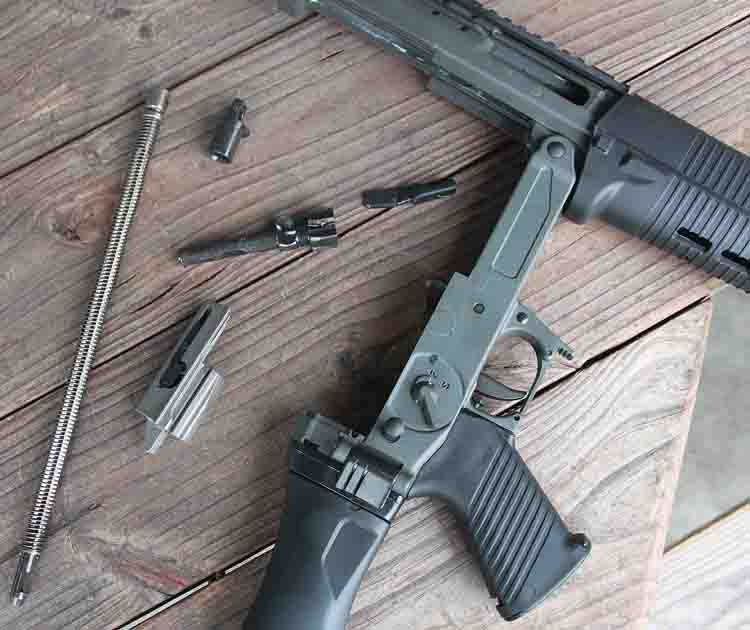
Ammunition tested with the SIG 551-A1 was a combination of Black Hills Ammunition 55gr TSX and 55gr FMJ, Hornady 60gr TAP, Wolf Ammunition Military Classic 55g FMJ, Winchester 55gr FMJ, Federal Premium Law Enforcement 55gr Triple Shok and 62gr Bonded SP loads. The 551-A1 kept all loads tested under 2-1/2 inches at 100 yards with the Hornady TAP and Black Hills 55gr TSX producing MOA groups out to 200 yards. This accuracy level justifies the urge to mount a magnified optic such as the Leupold VX-R. Overall, the accuracy level was more than acceptable considering the barrel’s thin .5-inch profile. Accuracy test protocol consisted of five three-shot groups with each ammunition type; group sizes were averaged. Velocity figures ranged from 2,800 fps to 3,100 fps over a RCBS chronograph.
Most range testing utilized the Wolf Ammunition Military Classic 55gr FMJ and Winchester 55gr FMJ loads. The steel cased Wolf Ammunition and brass cased Winchester ammunition performed without issue. Magazine change drills turned out to be a combination of AR and AK manipulation techniques. The SIG 551-A1 does have a bolt hold open feature after the last round is fired so it was possible to tilt/insert a fresh magazine home and hit the bolt hold open lever with your left hand to chamber a round. For the occasion when a magazine was changed without the bolt being held open or training doctrine dictates running the bolt every time, the user had to resort to a couple different methods ala AK. Either reaching over or under the rifle with your left hand and work the bolt, tilt the rifle over with the right hand on the pistol grip and work action with left hand, or switch rifle over to left hand and work bolt with right hand. None of these techniques were particularly hard to master, but different from what dyed-in-the-wool AR operators will be accustomed to.
Range testing commenced with functionality tests consisting of dumping multiple magazines at several targets in rapid fashion once sight zeros were verified. Any fighting rifle, regardless of chambering, must be reliable to be worthy of consideration. The folding rear stock is an immediate advantage found on the SIG 551-A1 compared to a traditional AR rifle with its buffer tube preventing a folding stock option. SIG is using a folding stock reminiscent of the design found on the classic SIG 550/551. The folding stock, once deployed, is very sturdy and does not exhibit any side-to-side or up-and-down wiggle. One observation worth reporting based on range time is that the single point sling attachment mounted between the receiver and folding stock pivot had tendency to contact the operator’s nose when firing. The situation was resolved by removing the single point attachment and using a Blackhawk Dieter CQD two point sling attached at the front handguard and rear stock.
Once the SIG 551-A1 proved reliable, it was then put through its paces on different rifle courses of fire at Echo Valley Training Center. Magazine changes, shooting from the non-dominant shoulder and unconventional positions around barricades helped to evaluate the SIG 551-A1. The easy coupling of the 551-A1s magazines proved advantageous during longer strings of fire. It was noted that magazines pouches designed for AR magazines will not work with the 551-A1 magazines; with AK style magazine carriers proving capable of accommodating the 551-A1 magazines. The SIG 551-A1 gas piston operating rod system proved its worth in keeping the bolt carrier group cooler and cleaner compared to the direct impingement AR rifles. At no point was there a need to adjust the 551-A1’s gas system into its second position to compensate for a dirty rifle even after hundreds of rounds were fired. The 551-A1’s gas piston steadily ejected empties briskly forward and to the right several feet away from the firing point.
SIG’s decision to utilize its proven gas piston operating system derived from the SG 550/551 in its rifles made here in the U.S. is a boon to the U.S. consumer. Partisan advocates will debate the merits of the 551-A1 models. The true purist will not be satisfied with anything other than a direct copy of the SG 550/551; there is nothing wrong with that.
However, the SIG 551-A1 is a solid performer that offers much with a more than a mere resemblance to the SG 550/551. Its operating method is a direct descendant if not actual copy of the SG 550/551 with operating controls also very similar combined with same magazine. This will be good enough for most who want to benefit from a design many consider to be the best assault rifle in the world.
| This article first appeared in Small Arms Review V16N1 (March 2012) |



